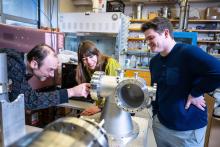UBC researchers have mapped what is likely the most comprehensive profile of microRNA expression across the hematopoietic hierarchy--the collection of primitive and differentiated cell types that develop from a common blood-forming stem cell.
Hematopoietic stem cells--found in bone marrow--are self renewing and have the ability to differentiate into all of the different mature blood cell types through a series of intermediate progenitor cell types. MicroRNAs are short RNA molecules that play a critical role in orchestrating this 'family tree' of cellular development. MicroRNAs usually silence, or turn off, genes at various stages of differentiation.
"How miRNA expression is controlled at each stage of the hierarchy is an important biological question for understanding this element of control," says Carl Hansen, Assistant Professor with Physics and Astronomy, UBC's Centre for High Throughput Biology (CHiBi) and Michael Smith Laboratories.
“Although there have been numerous studies of specific microRNA types in a few cell types, this study provides the first unified and comprehensive data set. We really wanted to see the big picture of how the microRNA expression is changing at each stage of differentiation."
The study--presented this August in the Proceedings of the National Academy of Sciences--included 27 blood cell populations, including eight populations of rare stem cells and progenitors. The sample blood cell populations were derived from mice.
"It's becoming clear that miRNA play a role, not only in blood cell type differentiation, but also in blood cancers," notes Hansen. "All this research is intended to better better understand these pathways and ultimately to improve treatment and diagnosis."
Results showed that microRNA patterns in primitive cell types that give rise to different “lineages” are in fact much more similar to each other than to their more differentiated progeny. They also showed that few microRNA are specific to a given cell type, highlighting that microRNAs work in concert with each other and other factors to establish and maintain genetic programs.
Challenges faced in this study include the simultaneous need for sensitivity, speed, and economy. Primitive stem cell populations are perhaps the most interesting to study but are not easy analyzed by conventional methods due to the scarcity of these cells. Similarly, very high sensitivity is required for the analysis of single cell miRNA expression in order to understand cellular variability, caused both by different cell types and natural noise between identical cells. Finally, the use of more traditional lab techniques for such global studies is prohibitively expensive and slow.
Hansen's team where able to overcome these challenges by using newly available microfluidic technology capable of testing arrays of 300 microRNAs and cycling 2,300 samples per run. "This really would have been--at best--a painstaking and expensive process without the benefit of high-throughput technology," notes Hansen. "This allowed us to economically generate a unified and comprehensive data set of miRNA expression."
The UBC contingent of the research team also included Professor James Piret from Michael Smith Laboratories, and researchers Oleh Petriv, F Kuchenbauer, Veronique Lecault and Adam White. The team also included stem cell researchers from the labs of Keith Humphries and Connie Eaves from the British Columbia Cancer Agency's Terry Fox Laboratory and Marco Marra’s group from the Michael Smith Genome Sciences Centre. “This study highlights the effectiveness of collaborative team research across many disciplines.”
Musqueam First Nation land acknowledegement
We honour xwməθkwəy̓ əm (Musqueam) on whose ancestral, unceded territory UBC Vancouver is situated. UBC Science is committed to building meaningful relationships with Indigenous peoples so we can advance Reconciliation and ensure traditional ways of knowing enrich our teaching and research.
Learn more: Musqueam First Nation
Faculty of Science
Office of the Dean, Earth Sciences Building2178–2207 Main Mall
Vancouver, BC Canada
V6T 1Z4


